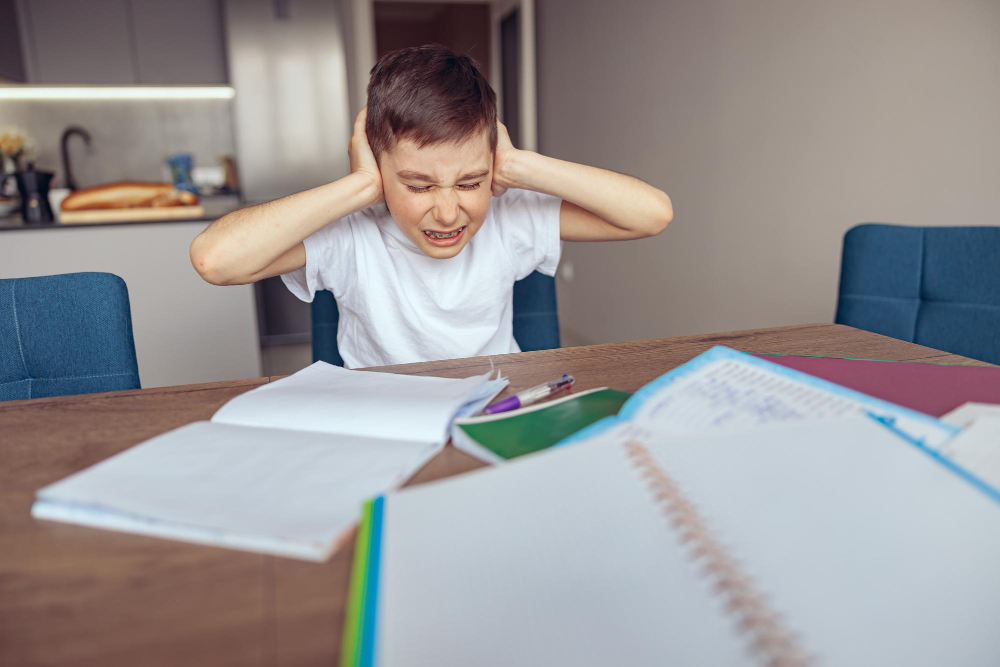Sensory Overload In Kids — What It Is, Symptoms, Behaviors, and Practical Strategies
What’s inside this article: An in depth look at sensory overload. Including what sensory overload means, sensory overload symptoms and behaviors, causes, prevention, and practical strategies to use with kids experiencing overstimulation and overload.
Is there a child in your life who seems to become anxious, panicked, overwhelmed, or perhaps even aggressive very easily? Do they seem especially sensitive to sounds, smells, textures, or crowds?
If you answered “yes” to those questions, their heightened sensitivity might be due to sensory overload, a condition in which the brain becomes overwhelmed by sensory input.
In this article, we’ll explore this topic in detail, explaining its meaning, symptoms and behavioral signs, and practical strategies for supporting someone experiencing sensory overload.
What Is Sensory Overload?
Sensory overload happens when the brain is bombarded with more sensory information (from sight, smell, taste, touch, sound, and movement) than it can handle.
This excess information causes feelings of anxiety, overwhelm, and discomfort, and when it’s not addressed, it frequently leads to meltdowns.
While everyone experiences overstimulation occasionally, certain people, especially those who are neurodivergent, are more easily triggered and experience overstimulation and sensory overload more frequently.
It may even interfere with their quality of life and make it hard (or sometimes impossible) for them to participate in certain activities.
What Causes of Sensory Overload?
Sensory overload occurs when one or more of the body’s senses experience overstimulation from the environment.
This causes the central nervous system to become intensely activated and overwhelmed by the amount of sensory data flooding in, disrupting the brain’s ability to process information efficiently.
Several factors can lead to sensory overload, and the triggers vary widely from person to person because some people are naturally more sensitive to certain stimuli than others.
Understanding what triggers your child’s sensory overload can help you find strategies to manage or minimize its impact.
Some of the key causes of sensory overload include:
1. Intense Sensory Input:
This may include loud noises, bright lights, strong smells, or certain movements. It’s more likely to happen in places with a lot of stimuli, such as crowded public places, busy streets, or events with lots of people and noise.
But remember, some people are naturally more sensitive to sensory input than others. It may happen in classrooms or during unstructured activities like outside at recess or on the playground.
2. Sudden Change in Environment:
Moving from a relatively calm environment to a more chaotic one can trigger sensory overload. Sometimes, the brain struggles to adjust to this kind of sudden shift.
For example, transitioning from a quiet classroom activity, like reading, into a louder or less structured activity, like music, gym class, or stations, can lead to overstimulation for some children.
3. Cognitive and Emotional Stress:
Stress heightens our sensitivity to sensory input. When someone is anxious or stressed, typically tolerable levels of noise, light, or other sensory inputs can become overwhelming.
So, if there have already been emotional triggers, frustration, changes to routine, or unmet needs like hunger or thirst, children are more likely to experience sensory overload. This means situations and stimuli that aren’t usually triggering for them can become triggering.
4. Fatigue:
When you’re tired, your brain’s ability to process sensory information decreases, making it easier to become overwhelmed by stimuli that are typically manageable. Fatigue diminishes the brain’s ability to filter and process sensory information effectively and also impacts emotional regulation.
Being tired also makes your nervous system more sensitive. This heightened sensitivity can make everyday sensory experiences seem more intense and overwhelming, leading to quicker sensory overload responses.
It’s important to make sure your child gets enough sleep. If you know your child is fatigued, reduce expectations and exposure to stimuli accordingly.
5. Neurodiversity:
Due to various neurological and sensory processing differences, people with autism, ADHD, or sensory processing disorders are more susceptible to sensory overload.
Neurodiverse individuals often have a reduced filtering ability. This means they might process more sensory input simultaneously, which can quickly become overwhelming and lead to sensory overload.
Neurodiverse individuals often have heightened sensitivity to sensory stimuli, meaning that their brains process sensory input more intensely than neurotypical individuals. This can make everyday sensory experiences overwhelming.
For people with conditions like SPD, the brain over-responds to sensory information. This over-responsiveness can cause certain sounds, lights, textures, or movements to be perceived as overwhelming or even painful.
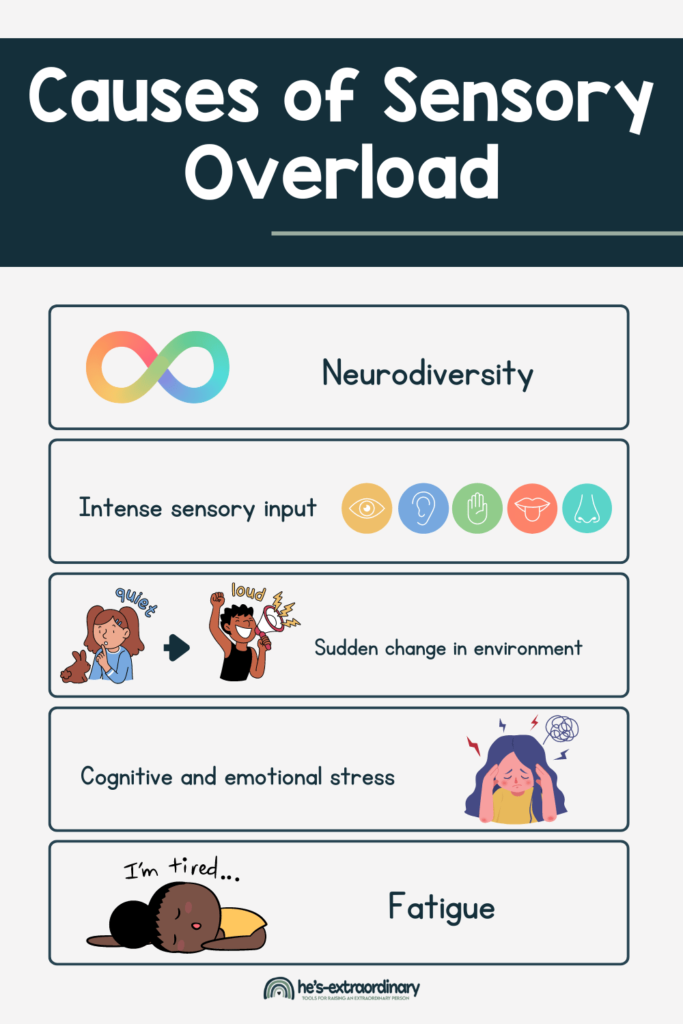
The Sensory Spectrum
The term “sensory spectrum” describes the array of sensory differences that exist from person to person. How we experience and interpret various stimuli is an individualized experience.
We all have what’s known as a neurological threshold, which is our tolerance to sensory input. This is measured by how much input is needed for us to have a reaction. Most of us fall between the two green lines in the diagram below.
If you have abnormally increased sensitivity, you’re considered hyper-sensitive. Hyper-sensitive people are more likely to experience sensory overload.
In contrast, some people are hypo-sensitive. These individuals may miss important cues from their bodies, like not realizing they are hungry until they are starving.
You can learn more about the sensory spectrum and sensory processing disorders here.
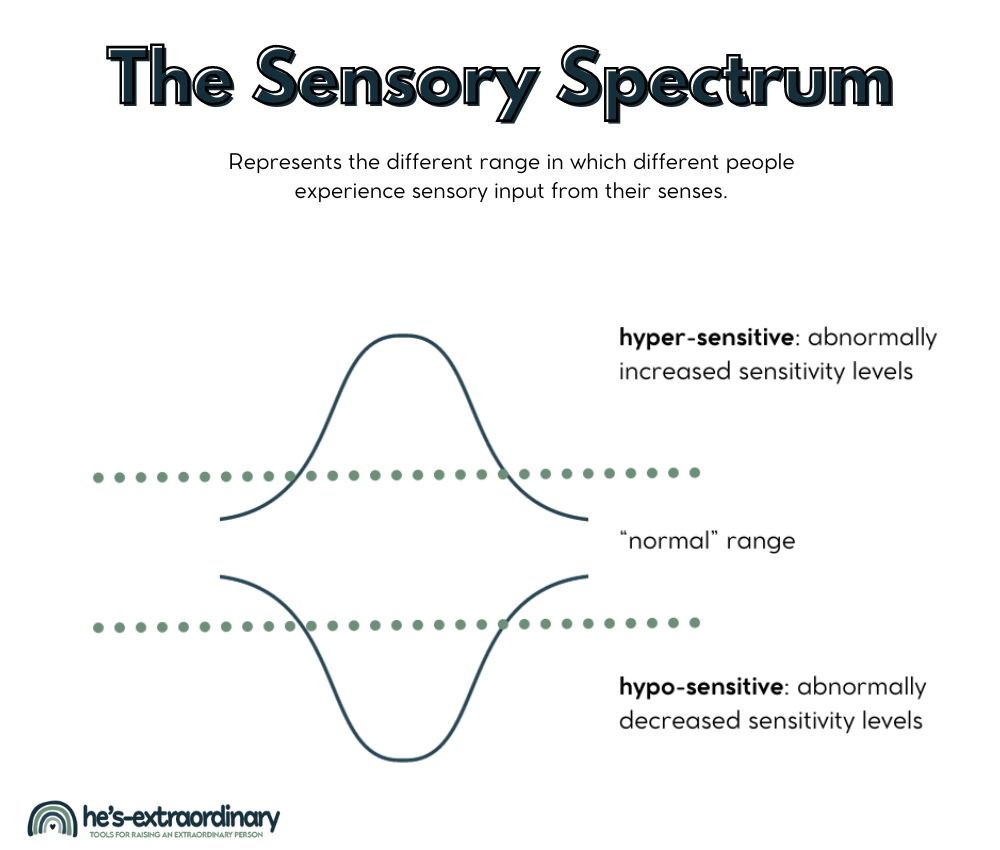
Additionally, we all have sensory preferences. These are things we enjoy and avoid. This is called a sensory bias. It’s the reason why people have different preferences for foods, music, activities, etc.
Sensory bias is normal and only poses a problem when it severely restricts or limits productivity or chronically interferes with enjoyment in life.
Conditions Related to Sensory Overload
Anyone can feel sensory overload. However, people with the following conditions may be more sensitive to stimuli and more likely to experience sensory overload symptoms:
- Autism
- ADHD
- Sensory Processing Disorder
- PTSD (or children who had adverse childhood experiences – ACE’s)
- Fetal Alcohol Syndrome
- Down Syndrome
- Tourette’s
- Other developmental disorders
Signs and Symptoms of Sensory Overload
Sensory overload is a challenging and overwhelming experience with a wide range of physical and emotional responses.
It is essential for caregivers and educators to understand sensory processing differences and recognize the signs of sensory overload in children. This knowledge can help you significantly reduce meltdowns and help build a sensory-friendly environment where children thrive.
Symptoms of Sensory Overload – What Does It Feel Like?
Sensory overload can cause a variety of physical and emotional symptoms and can vary from person to person.
Some commonly reported symptoms of sensory overload include:
- Extreme irritability or agitation
- Intense overwhelm
- An urge to cover your ears, eyes, face, or to run away from a situation or place
- Feelings of anxiety or fear
- Wanting everything around you to just “pause”
- Disoriented
- An inability to ignore sensory inputs (loud sounds, strong smells, etc.)
- Unable to focus
- Overheating or dizziness
- Headaches
- Confusion
- Racing thoughts
- Social withdrawal
- Physical outbursts
- Meltdowns or shutdowns
These feelings can range from mild to severe and worsen the longer the person is exposed the overwhelming stimuli.
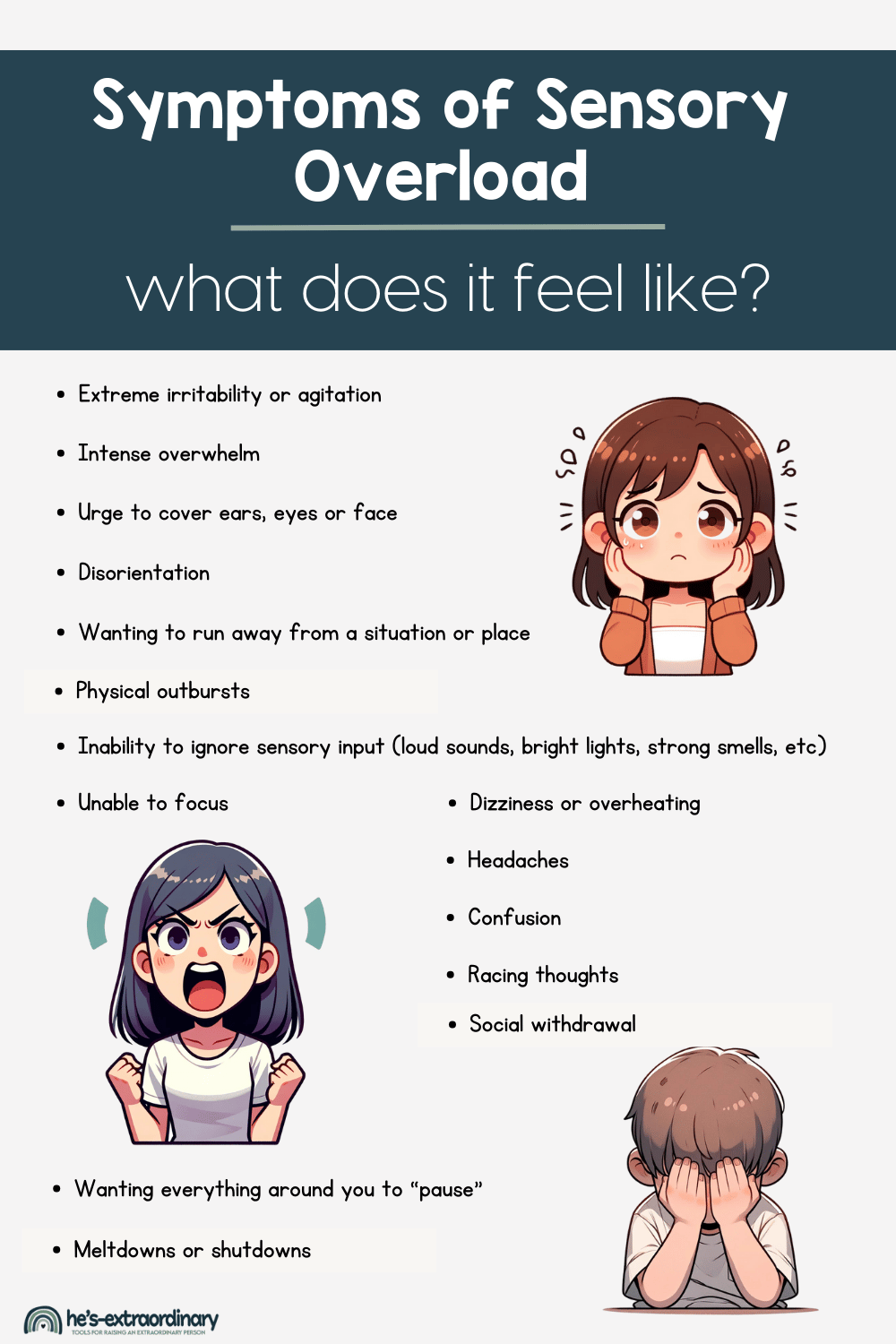
Signs of Sensory Overload – What Does It Look Like?
If a parent or teacher doesn’t know what to look for, it might be hard for them to tell when a child is experiencing sensory overload.
Sometimes, it seems like kids are intentionally acting out, avoiding school work, or being defiant. With sensory overload or a sensory meltdown, this is not the case.
If your child is experiencing sensory overload, you may notice some of the following behaviors:
- Crying or Screaming: Your child may become upset and start crying or screaming in response to overwhelming sensory input.
- Covering Ears, Eyes, or Face: They may cover their ears or eyes to block out overwhelming sounds or sights or cover their face with their hands or clothing.
- Restlessness or Fidgeting: Increased movement, such as fidgeting, rocking, or pacing, as a way to cope with the sensory input.
- Withdrawal: Your child may withdraw from social interactions, become quiet, or try to escape to a quieter place away from other people.
- Aggressive Behavior: Aggressive behaviors, such as hitting, kicking, or biting, may be a reaction to feeling overwhelmed.
- Defiance: Not following instructions on expectations, refusal of tasks or school work that is perceived as defiance may be because your child is confused and overwhelmed by overstimulation.
- Meltdowns: Intense, uncontrollable outbursts that are often mistaken for tantrums but are actually a nervous system response.
- Tantrum-like Behavior: Behaviors similar to tantrums, such as yelling, flopping to the ground, or refusing to comply with requests, may be their way of communicating discomfort or avoiding sensory input that overwhelms them.
- Avoidance or Escape: Attempts to leave the environment, such as running away or hiding.
- Clinging to a Parent or Caregiver: Seeking comfort and security from a trusted adult, often by clinging to them.
- Difficulty Communicating: Trouble expressing what they are feeling or needing due to being overwhelmed by sensory input.
- Self-soothing Behaviors: Engaging in repetitive actions like rocking, humming, hand flapping, or sucking on a thumb to calm themselves.
- Physical Signs of Distress: Visible signs such as sweating, trembling, changes in body language, or facial expressions may indicate your child is overwhelmed.
Children often can’t communicate directly that they are feeling overwhelmed or experiencing sensory overload. They may not even know this is what’s wrong, but they just feel distressed and can’t explain it. So, it’s important to notice their behavior and try to reflect on what’s happening on the inside.
There’s always a reason for misbehavior, even when we can’t see it.
Desensitization due to Sensory Overload
In some cases, the brain may respond to overwhelming sensory input by shutting down some sensory processing to protect itself from the overload.
This can lead to numbness or a sense of detachment from one’s surroundings.
This can be challenging to recognize when it’s occurring in a child because their behavior isn’t disruptive the way it is during a meltdown.
But there are signs to watch for:
- Withdrawal: Suddenly withdrawing from conversations or social interactions, seeming disconnected or disinterested.
- Flat Affect: Facial expressions become less animated or entirely neutral, and their voice may lack its usual inflections.
- Reduced Responsiveness: You might notice delayed responses in conversation or a lack of response to external stimuli, like not reacting to sounds or touches that would normally get their attention.
- Seeming Fatigued or Zoned Out: They may look tired, have heavy eyelids, or seem like they are “zoning out” or staring into space.
If you notice these signs of desensitization, especially in a loud classroom or another stimulating environment, it can help to offer a quiet break to see if they start acting like their normal selves again.
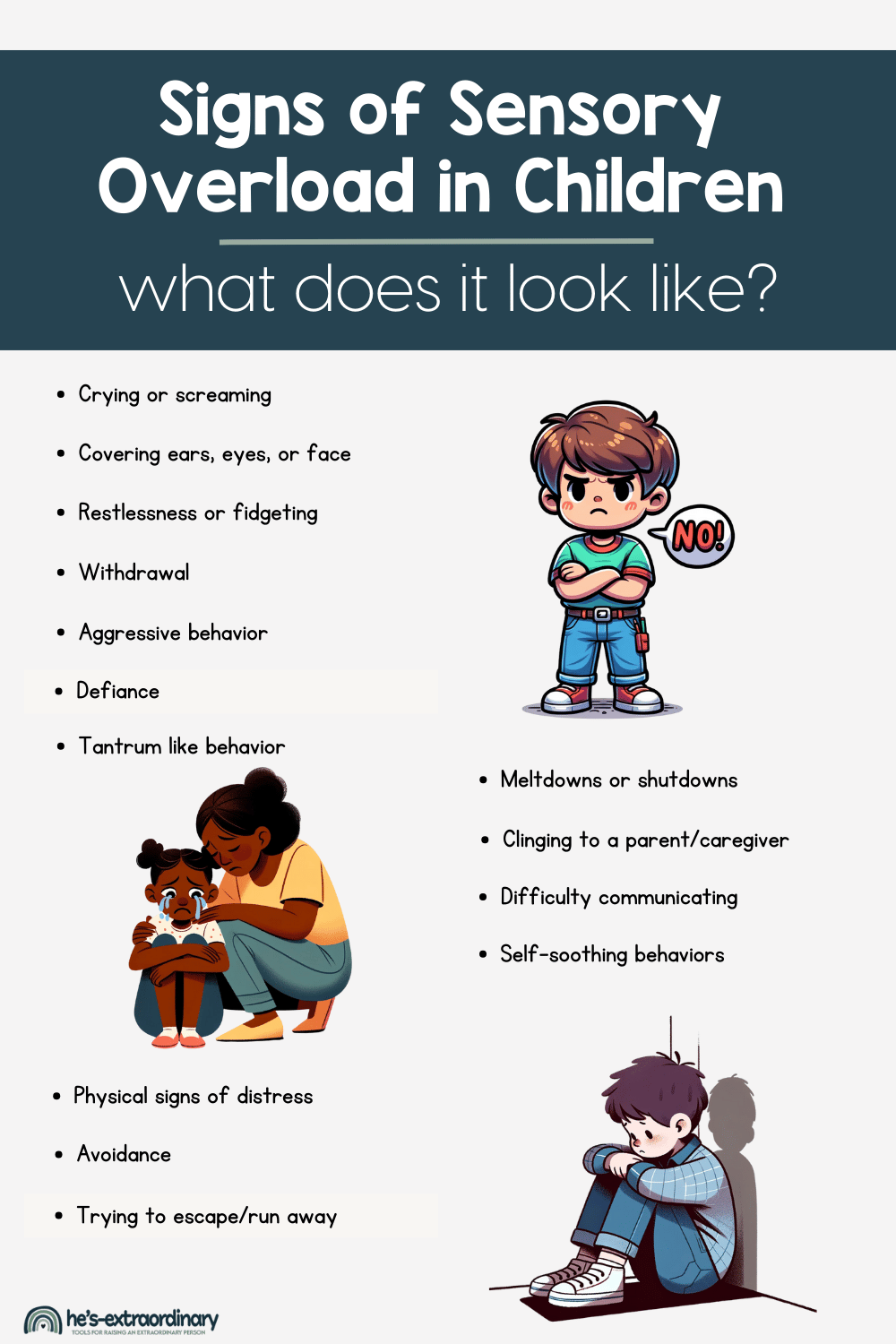
Strategies for Sensory Overload in Kids
Recognizing and responding to sensory overload in children is crucial. You can use various strategies to provide kids with relief during an episode of sensory overload.
It’s also important to take preventative steps to reduce the occurrence of overstimulation.
Relieving Sensory Overload:
When a child is experiencing sensory overload, you can help relieve their overstimulation by finding a way to dim or remove the sensory input that’s overwhelming them.
Some strategies for relieving sensory overload include:
- Calm Down Corners: Create a quiet, comfortable space with soft lighting, calming colors, and sensory tools like weighted blankets and stress balls. Encourage the child to retreat to this space when feeling overwhelmed. Read: How to Create the Ultimate Calming Corner.
- Sensory Tools: Use sensory tools designed to block out external feedback, creating a calming or desensitizing environment. For example, noise-canceling headphones or earplugs, weighted blankets, or sensory swings.
- Change the Environment: Dim the lights, lower the volume, or change the seating arrangement or expectation. If it’s possible to adjust the stimuli that are affecting your child, make immediate modifications. If you can’t alter the stimuli, remove the child from the triggering environment. You could go for a walk, set up an alternate work environment, or move to the calming corner or another location for a break.
- Simplify the task: If your child is overwhelmed due to overstimulation, it’s more difficult to focus and follow expectations. These factors combined can create a really triggering situation. Temporarily reduce expectations or simplify the task your child’s working on.
- Make Sure Unmet Needs are Met: Offer a cold drink or snack to address possible unmet needs that are increasing sensitivity to stimuli. This, paired with a break to remove them from the overstimulating environment, can help prevent the sensory overload from reoccurring.
It’s also important to make children feel supported and validate their feelings when they are overstimulated. Emotion coaching is a great communication tool for this.
Scolding a child for their behavior or dismissing their experience by telling them to “get over it” is not helpful and may lead to more challenging behavior, or as the overload continues, they may have a meltdown.
Develop an Exit Strategy:
If possible, work collaboratively with your child on an exit strategy they can use to remove themselves from overwhelming situations ahead of time.
For example, if you’re having guests over at your house, make it clear ahead of time that they can go to their room and take a break from all the guests who are talking loudly around them without asking permission or excusing themselves from the room first.
At school, they may have a hand signal or a hall pass they can use to communicate the need to leave the classroom and move to a pre-determined quiet location for a break or to complete class work.
Self-regulation Strategies:
Self-regulation strategies help calm down our nervous system. This can help kids get back to their base level after being overstimulated. It’s important to remember that you need to teach and practice self-regulation strategies to your child when they are calm.
Children can’t learn new skills when they are overwhelmed or overstimulated. With regular practice, you’ll be able to successfully prompt your child to use self-regulation strategies after they’re separated from the overwhelming stimuli.
Some effective self-regulation strategies include:
- Deep Breathing Exercises: Deep breathing regulates our arousal level, helping us calm our bodies and achieve self-regulation. Here, you can learn how to teach children the correct deep breathing technique and find various child-friendly deep breathing exercises. (Includes printable posters)
- Mindfulness: Practice mindfulness activities to increase awareness of the present moment and reduce the impact of overwhelming stimuli. Techniques include body scans, progressive muscle relaxation, mindful coloring, and guided meditations. Find 9 mindfulness activities here.
- Exercise: Exercise like yoga, stretching, or taking a nature walk can help regulate the nervous system and temporarily remove your child from the triggering situation.
- 5-4-3-2-1 Grounding: This very simple relaxation strategy helps ground you, and you can use it nearly anywhere. Download the free poster with instructions here.
For a more comprehensive list of self-regulation strategies, read: 120 Emotional Self-Regulation Strategies and Techniques and 17 Simple and Fun Relaxation Techniques for Kids. All children are unique, so it’s important to find a few effective strategies that work for your child. Take the ideas that are helpful to you and leave the rest.
Preventing Overstimulation and Sensory Overload
Knowing how to help stop sensory overload is important. But being able to prevent it from happening in the first place is even better.
Some of the most effective strategies for preventing sensory overload include:
- Identify your child’s triggers and plan ahead to avoid them or reduce their intensity
- Have a safe, calming space your child can use when overwhelmed.
- Have a sensory room where they can explore sensory input safely or use calming sensory tools.
- Use tools to minimize sensory input, such as noise-reducing headphones or fluorescent light covers.
You can read more detailed and specific prevention tips here.
Teachers: Create a Sensory-Friendly Classroom
Creating a sensory-friendly classroom can help all students, especially those with sensory processing challenges, to feel more comfortable and able to focus on learning. A sensory-friendly classroom will reduce incidences of sensory overload for both you and your students.
Here are some strategies to make a classroom sensory-friendly:
- Lighting: Use natural light as much as possible. If artificial lighting is necessary, consider using soft, warm lights and avoid or cover fluorescent lighting, which can be harsh and flicker.
- Sound Control: Children are loud, especially in elementary classrooms, but they’re loud at all ages when they’re in large groups, like in a classroom. Use sound-absorbing materials such as carpets, curtains, and wall panels to reduce noise levels. You could also try using white noise machines or soft background music to mask distracting sounds if your classroom can hear the other classes or if outside noise is a problem.
- Flexible Seating: Provide a variety of seating options, such as bean bags, floor cushions, standing desks, and wobble stools to accommodate different sensory needs and preferences.
- Sensory Breaks: Integrate regular breaks throughout the day where students can engage in sensory activities like stretching, deep breathing, using sensory toys, or physical exercise. Check out this 7-minute HIIT workout for self-regulation.
- Individual Workstations: Set up individual workstations with minimal distractions for students who need a quiet space to focus.
- Personal Sensory Kits: Create personal sensory kits for students containing items that help them self-regulate, such as noise-canceling headphones, weighted lap pads, or chewable jewelry.
By implementing these strategies, educators can create a sensory-friendly classroom environment that supports the sensory needs of all students, reducing the likelihood of sensory overload and making tools for managing overstimulation accessible to their students.
Occupational Therapy
Consider consulting with an occupational therapist if you’re observing recurring signs of overstimulation in your child.
An occupational therapist can offer invaluable expertise for children frequently dealing with sensory overload. They can evaluate a child’s unique sensory requirements and design a tailored sensory diet, a specialized set of activities to accommodate their sensory needs and alleviate sensory processing challenges.
The more you know about sensory overload, the easier it is to support your child and help them to feel safe.
The following articles may help you prevent or stop sensory meltdowns or overload.
- 18 Effective De-Escalation Strategies
- Sensory Diet Activities
- The Sensory Spectrum and Sensory Processing Disorders
- 50+ Student Accommodations to Help Kids Succeed at School

